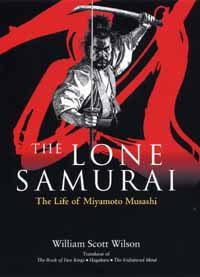Our Sponsor, SDKsupplies

Review by Colin Watkin. Copyright © Hyoho.com 2004. All rights reserved
The Lone Samurai: The Life of Miyamoto Musashi
by William Scott Wilson
Kodansha International, 287 pp.
Hardcover, $24.00 US ISBN: 4-7700-2942-X
http://www.kodansha-intl.com/
My first impression was of course the book cover. Sad to say it's an artists affectation of a rather strange pose/kamae. Most people are very familiar with Musashi's actual portrait in Gedan Kamae and other prints. I know that authentic pictures have already been used on a number of occasions but as the book is a work on Musashi's history, I felt that the cover was inappropriate. So my first opinion would be, "Don't judge this book by it's cover".
The book is well laid out as is all of Mr Scott Wilson's literature. It covers work from no less than twenty four writings and records and from the commemorative stone I have visited many times to practice before and offer a prayer to the founder.
As Mr Scott Wilson himself explains there are many accounts of Musashi's life which may differ even as to where he was actually born, that can and do create supposition. I would regret to say that there is also possibly an element of supposition on the part of Mr Scott Wilson and would hope that the book is not quoted in future as some sort of bible on the "Real Musashi". I would not go as far as to describe the book as Non-Fiction, but more of a factional work.
The book mentions a possible connection between Musashi's Nito Seiho and Japanese drumming. I had read this elsewhere but find this to be a little far fetched as the two hand action bears little resemblance.
In describing the possible sword action on Ganryu Island there also seemed to be a lot of supposition. As no one that actually witnessed it went on record, we can only guess. I had recently heard from a historian in Kokura the possibility that it was Sasaki that was late. Also of course we know little of Sasaki's waza. It's a pity nobody talked to the boatmen.
But on the whole, considering Mr Scott Wilson has never practiced in Musashi's way, in order to experience some of the intricacies of Musashi's words, I think he has done an excellent job. He brings together a lot of facts that give us a very good idea about Musashi's life and his thoughts.
The account of the match with Miyake Gunbei is amazing and very clearly describes Nito Seiho waza as practiced today. I even found myself trying to visualize the action.
Mr Scott-Wilson explores the many rumors such as skin complaints and cleanliness to add some reality and hopefully put them to rest. He states that clearly Musashi would not even have been granted an audience, let alone have a friendly relationship, with such people as Honda, Ogasawa and Hosokawa if his cleanliness was in doubt.